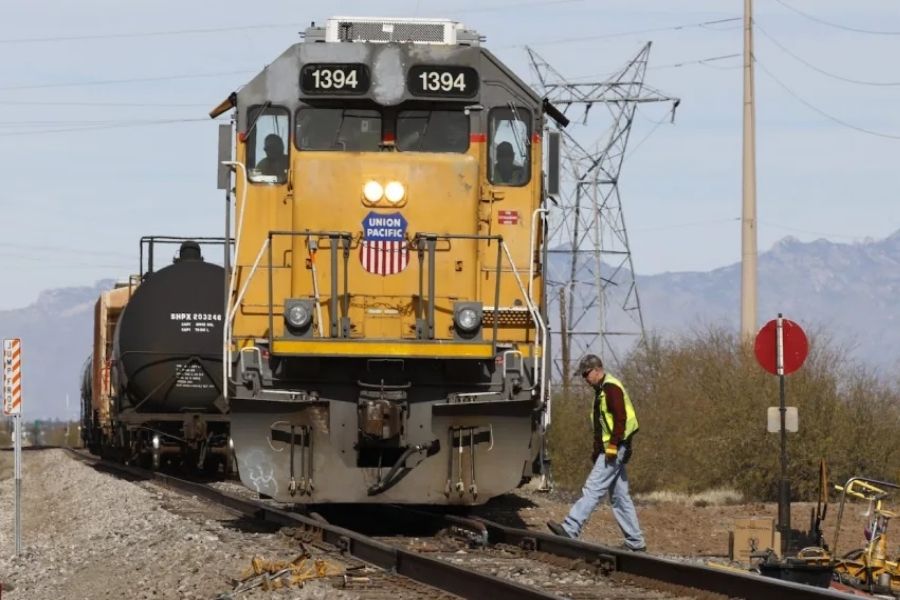
On Jan. 24, 2020, a Union Pacific freight train crew works at a siding south of Tucson, Ariz. (David Boe/AP Photo/File)
Las Vegas Railroad Strike Will Cost $2 Billion per Day
By TheNevadaGlobeStaff, September 19, 2022 8:05 am
LAS VEGAS- After 20 hours of talks between railroad unions and federal labor officials on Wednesday, news that a deal had been reached eased fears of a nationwide strike in a country that was already tired of supply chain problems. The strike would have cost about $2 billion a day, according to estimates.
The threat of a rail strike in Las Vegas brought up strikes from a hundred years ago and gave people a chance to look at how the city works with railroads now. Las Vegas was founded as a railroad town in 1905, when the townsite was sold at an auction. It still depends on the railroad, which moves goods from coast to coast, for its daily life.
Promises of a high-speed train between Southern California and Las Vegas keep people interested in the future of railroads here.
Even though Las Vegas is no longer a railroad town, trains are always around because they move goods along Interstate 15. Las Vegas and every other city that depends on rail transportation would have been hurt by a strike.
Symphony Park
People sometimes say that a city doesn’t have much culture, but the Union Pacific Railyard development, which is now called Symphony Park, became the center of a growing cultural scene. In the past, Las Vegas had a busy railyard, but it has since moved to Arden, which is south of the city. This is part of the city’s careful planning for continued growth that is rich in architecture, business, and urban living spaces.
Over the rail line, pedestrian bridges connect Symphony Park to downtown, and Las Vegas keeps changing with new projects that are only a few yards from the historic maintenance yard where diesel engines between Los Angeles and Salt Lake City were fixed.
The city took a long time to decide how to develop the railyard, and the process is still going on, but the site is an important part of the city’s future.
Labor Troubles
The threat of a strike came at a time when railroads were making more money than ever, even though workers hadn’t gotten a raise since 2019. A report from the Associated Press says that the five-year deal, which goes back to 2020, includes the 24% raises and $5,000 bonuses that a Presidential Emergency Board suggested this summer. But in response to some of the unions’ concerns about working conditions, the railroads also agreed to loosen their strict attendance rules. Find out more about the deal.
A hundred years ago, there was a strike in Las Vegas because Union Pacific decided to lay off 60 workers from Las Vegas repair shops. UNLV historian Michael Green says that there were about 2,300 people living there at the time. After Senator William Andrews Clark of Montana sold his share of the railroad to Union Pacific in 1921, fewer people were hired. Clark County is named after Clark.
Even though Las Vegas didn’t have a lot of unions at the time, this led to labor problems all over the city.
The railroad hired people to stop the strike, and when violence broke out between strikers and railroad workers, Nevada’s governor called in the state police.
The strike went on for most of 1922.
Passenger trains
Freight trains would have been most affected by a strike, but some commuter trains would have also been affected if they used freight railroads’ tracks.
Most of the recent railroad news from Las Vegas has been about Brightline West, the company that plans to start building tracks soon for a high-speed train to Southern California. Brightline wants to build a station between Warm Springs Road and Blue Diamond Road on Las Vegas Boulevard. The project is likely to cost between $8 billion and $10 billion.
In October, when grants for high-speed rail projects are likely to be given out, there will be more news.
After plans that only went to Victorville didn’t get enough support, extending the train to Rancho Cucamonga is seen as very important to its success.
The 260-mile trip on the high-speed train is thought to take about three hours.
Credits: 8NewsNow
Copyright 2022 702 Times, NV Globe. All rights reserved.




